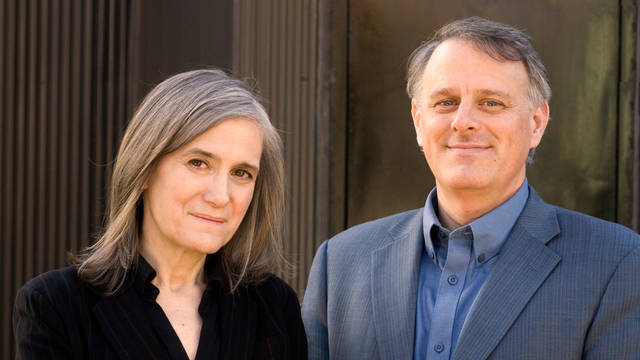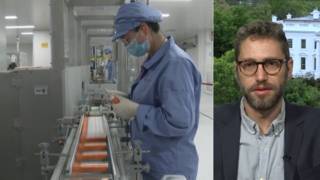
Topics
By Amy Goodman & Denis Moynihan
“Nobody saw it coming. Nobody in the whole world. Who saw it coming?” That was President Joe Biden speaking on ABC Wednesday about the COVID-19 Omicron variant. In fact, many people saw it coming. Global health experts and activists have been warning for more than a year that aggressive variants of the virus are essentially guaranteed as long as much of the world’s population remains unvaccinated.
We are now entering the pandemic’s third year, with more than 277 million reported cases and 5.4 million deaths worldwide. The Omicron variant is spreading with unprecedented speed, infecting even the vaccinated and the boosted. Despite this, vaccination remains the best way to avoid serious illness or death by COVID-19. Yet vaccines remain out of reach for much of the world’s population. Many of the effective vaccines and treatments were developed using taxpayer money, with scientists at public health institutions and using other public resources. Nevertheless, pharmaceutical corporations are demanding top dollar for these life-saving products, withholding the vaccine formulas while millions continue to get sick and die. Greed should not determine the course of this pandemic.
“No company, however powerful, should be able to dictate who lives and who dies, or exercise outsized influence over whether the global economy prospers or grinds to a halt. But Moderna is doing just that,” Diana Kearney, a Legal and Shareholder Advocacy Advisor at Oxfam America, said this week in a statement accompanying Oxfam’s complaint to the U.S. Securities and Exchange Commission (SEC). Central to Oxfam’s argument to the SEC is a dispute between Moderna and the U.S. National Institutes of Health (NIH). Moderna filed a patent claim in July that listed only its scientists; the NIH says three of its own, publicly-financed scientists – John Mascola, Barney Graham and Kizzmekia Corbett – played key roles in the vaccine’s discovery. If the U.S. can prove it belongs on the patent, Moderna would lose some control over how the vaccine gets manufactured and distributed.
Oxfam bought stock in Moderna, and thus holds shareholder rights. As a publicly traded company, Moderna must submit extensive filings to the SEC, informing its investors and the public of the company’s finances and explaining any risks the company is facing. In its complaint, Oxfam alleges Moderna has been lying about the seriousness of its patent conflict with the NIH and the U.S. Department of Justice, and is hiding pending litigation that could cause a significant drop in its share price.
Oxfam’s strategic use of securities law is part of a wider strategy to achieve vaccine equity. It’s part of The People’s Vaccine Alliance, a global coalition pressuring for development of COVID-19 vaccines as a common good, fairly distributed to everyone, everywhere, for free. Achal Prabhala, coordinator of AccessIBSA, which campaigns for access to medicines in India, Brazil and South Africa, is a key organizer with the project.
“Unless something dramatically changes with vaccine supply, we are condemned to repeat these horrific cycles of surges and infections and unknowns,” Prabhala said on the Democracy Now! news hour. He co-authored a recent report from AccessIBSA and Doctors Without Borders, describing over 120 manufacturers in Asia, Africa and Latin America with the technical requirements and quality standards to make an mRNA vaccine.
“If the mRNA technology that Pfizer and BioNTech and Moderna have developed and deployed…were to be shared with any number of these 120 companies, we could vaccinate the world in close to six months,” Prabhala explained. “It’s not theoretical. It’s based, in fact, on a model of existing partnerships that companies like Moderna have with very similar manufacturers, except they’re located in Spain instead of Bangladesh or Senegal or Tunisia.”
According to the latest data from the World Health Organization, more than two-thirds of people in high income countries have received at least one COVID-19 vaccine dose; in low income countries, less than a tenth of the population has received one. There are still countries, mainly in Africa, where the vaccination rate is at or below one percent.
Lifting patent restrictions “loosens Moderna, Pfizer and BioNTech’s stranglehold on these vaccines,” Prabhala said. “It undercuts the massive tens of billions of dollars of profit and revenue that they can earn off selling to poor countries in the next couple of years, once they’re done with rich countries.” He offered a solution: “President Biden can bring Moderna to the White House, sit them across the table, say that we have laws that can force you to do what we are asking you to do, but we’d rather you just do it instead, work out that agreement, and then let it go and take credit for vaccinating the world.”
Vaccinating the world is the way out of this pandemic. No one is safe until everyone is safe.












Media Options